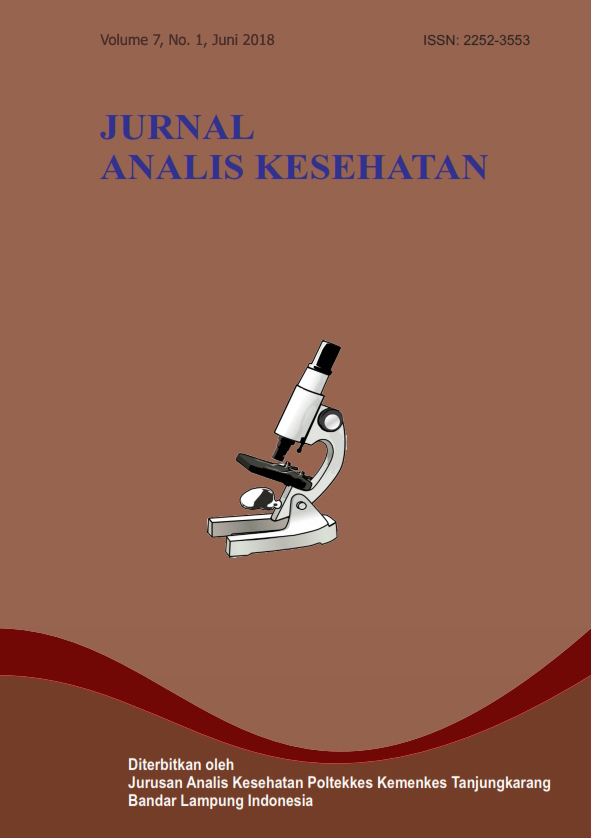Identifikasi Potentially Inappropriate Medications (PIMs) Berdasarkan Kriteria STOPP START pada Pasien Geriatri Rawat Inap di RS Advent Bandar Lampung
DOI:
https://doi.org/10.26630/jak.v7i1.912Keywords:
Geriatri, STOPP STARTAbstract
Identifikasi peresepan obat pada populasi geriatri sangat penting untuk terus dilakukan karena peresepan yang membahayakan pada populasi ini akan berasosiasi dengan peningkatan morbiditas, terjadinya kejadian yang tidak diinginkan terkait obat, dan mortalitas. Tujuan penelitian ini adalah untuk mengidentifikasi PIM (Potentially Inappropriate Medication) pada pasien geriatri rawat inap di RS Advent Bandar Lampung pada tahun 2016 berdasarkan Kriteria STOPP START. Jenis penelitian ini adalah deskriptif. Populasi dalam penelitian ini adalah seluruh rekam medik pasien geriatric yang berobat rawat inap di RS Advent Bandar Lampung tahun 2016 dengan jumlah sampel sebanyak 72 rekam medik. Uji statistic yang digunakan adalah  uji Chi square. Identifikasi penggunaan PIM disesuaikan dengan criteria STOPP START. Hasil analisis univariat menunjukkan tiga jenis PIM terbanyak pada pengobatan pasien geritari di RS Advent Bandar Lampung adalah tidak digunakannya statin pada pasien yang memiliki riwayat penyakit jantung koroner dan cerebral vascular disease (51,28%), adanya duplikasi kelas obat (17,95%), dan penggunaan benzodiazepine pada pasien yang berisiko jatuh (11,43%). Analisis bivariat menunjukkan tidak ada hubungan secara bermakna antara kejadian PIM dengan jenis kelamin, usia, jumlah obat yang diberikan, komorbid, dan lama rawat.
References
Alexxander, Nugroho, Agung Endro., Pinzon Rezaldi T., (2016). peranan obat golongan statin terhadap luaran status fungsional pasien stroke iskemik berulang di rumah sakit. Jurnal Manajemen dan Pelayanan Farmasi : 1-12
American Pharmacist Assotiation. (2010). Geriatric Dosage Handbook 17th edition. USA : Lexicomp
Beckett NS, Peters R, Fletcher AE, et al. for the HYVET Study Group. Treatment of hypertension in patients 80 years of age or older. N Engl J Med. 2008;359:971–974.
Chien-Liang Liu, Li-Ning Peng, Yi-Tsu Chen, Ming-Hsien Lin, Li-Kuo Liu, &Liang-Kung Chen. (2012). Potentially Inappropriate Prescribing (IP) for Elderly Medical Inpatients in Taiwan : A hospital-based study. Archives of Gerontology and Geriatrics, 148-151
Dicker, A.G., Weir, C.J., Lees, K.R. (1997). Influence of cholesterol on survival after stroke: retrospective study’, BMJ, 314:1584-1588.
Elia, Joe,. (2017). In the Elderly, Add PPIs to Aspirin for Secondary Prevention. NEJM Journal Watch.
Elliott, William J & Black, Henry R. (2002). Treatment of Hypertension in the Elderly. "http://www.medscape.com/viewpublication/409" The American Journal of Geriatric Cardiology
Gallagher, P., & O'Mahony, D. (2008). STOPP (Screening Tool of Older Person's Potentially Inappropriate Prescriptions) : Application to Acutely ill Elderly Patients and Comparison with Beers' Criteria. Age and Ageing Oxford Journals , 673-678.
Mayor, Susan. (2017). Older patients should take PPIs to cut risk of bleed from aspirin, study says. London : BMJ TResearch News
Madhusoodanan S & Bogunovic OJ., (2004). Safety of Benzodiazepines in The Geriatric Polpulation.New York : Pubmed
Moonis, M., Kane, K., Schwiderski, U., Sandage, B.W., Fisher, M.. (2005), ‘HMG-CoA Reductase Inhibitors Improve Acute Ischemic Stroke Outcome’, Stroke, 36:1298-1300.
Primedje, D. P., Bojita, M. T., & Popa, A. (2016). Potentially Inappropriate Medications in Elderly Ambulatory and Institutionalized Patients : An Observational Study . BMC Pharmacology and Toxicology , 1-10.
Puspitasari, Rara Merinda. (2013). Uji Efektivitas "screening Tool For Older Peoples' Prescription" terhadap pengobatan yang berpotensi tidak tepat pada pasien geriatri di RSUD Kota Depok. Depok : Universitas Indonesia
Reeves, M..J, Gargano, J.W., Luo, Z., Mullard, A.J., Jacobs, B.S., Majid, A., dkk. (2008). National Acute Stroke Registry Michigan Prototype Investigators: Effect of pretreatment with statins on ischemic stroke outcomes. Stroke, 39:1779-85.
Shahezwan, M., Wahab, A., Nyfort-hansen, K., & Kowalski S.R., (2012). Inappropriate Prescribing in Hospital Australian elderly as determination by STOPP Criteria. Int J Clin Pharm, 34. 855-862
Setiati, S. (2013). Geriatric Medicine, Sarkopenia, Frailty dan Kualitas Hidup Pasien Usia Lanjut Tantangan Masa Depan Pendidikan, Penelitian dan Pelayanan Kedokteran di Indonesia. Geriatric Medicine, Sarkopenia, Frailty Journal , 240-250.
Ubeda, A., Ferrandiz, M. L., Maicas, N., Gomez, C., Bonnet, M., & Peris, J. E. (2012). Potentially inappropriate prescribing in institutionalised older patients in Spain:the STOPP-START criteria compared with. Pharmacy Practice , 83-93.
Uchiyama., Sinichiro et al. (2016). Aspirin for Stroke Prevention in Elderly Patients With Vascular Risk Factors Japanese Primary Prevention Project. Ahajournals, 1605-1611.
Yoon, S.S., Dambrosia, J., Chalela, J., Ezzeddine, M., Warach, S., Haymore, J. (2004). ‘Rising statin use and effect on ischemic stroke outcome’, BMC Medicine, 2:4-7.
Wilmot, Kobina., Khan, Abdullah., Krishnan, Sandeep., Eapen, Danny J., & Sperling, Laurence. (2015). Statins in the Elderly : A Patient-Focused Approach. Clin. Cardiol. 38, 1, 56–61.
Downloads
Published
Issue
Section
License

Jurnal Analisis Kesehatan is licensed under a Creative Commons Attribution-ShareAlike 4.0 International License.
Based on a work at https://ejurnal.poltekkes-tjk.ac.id/index.php/JANALISKES.








